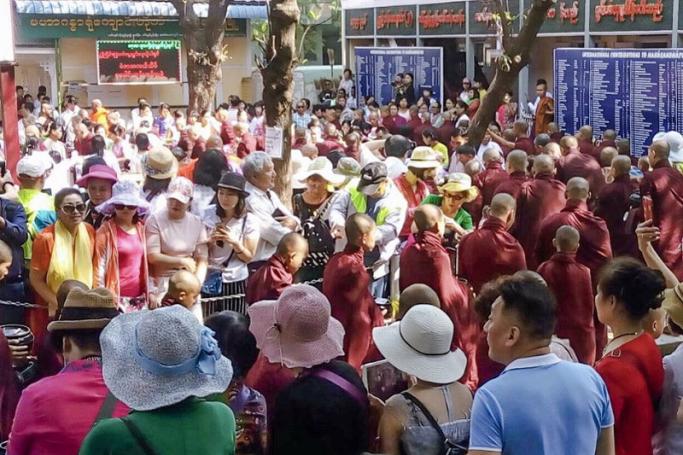Buddhist monasteries have always been one of the prominent visiting spots in Myanmar for tourists. With the influx of travelers in Myanmar, a lot of travel agencies bring visitors to the monasteries, and even the monastic colleges, attempting to provide visitors with a glimpse of the fundamental knowledge of the Buddhist teachings and principles.
But is there a downside?
Myanmar is known for its plethora of monasteries. Since Myanmar is predominantly a Buddhist country, there are a number tourists who are interested to visit the monasteries as well as the monastic colleges in order to delve into the religion and culture as well as to understand the life of the monkhood.
“It’s really a great chance for me to understand more about the daily routine of monk. And it’s just like a cultural sharing and exploration of religion in Myanmar. Since Buddhism and monkhood are famous in Myanmar, as a foreigner, I will want to learn more about these,” Anne Heden, a European visitor, said.
Given that many people follow Christianity in Europe, Europeans seldom have the opportunity to experience Buddhism and take part in Buddhist rituals. This kind of sightseeing is far from mere entertainment, but more about cultural exploration and appreciation.
One of the tourist spots in Mandalay, Mahagandhayon Monastery, is arguably one of the most renowned monastic schools in Myanmar. Whilst there is a limit to how deep tourists can delve into the life of a monk, there is still the opportunity at this monastery to observe the daily ritual of monks queueing to enter the dining hall for their final meal of the day at around 10:30 am. Many tourists come at 10am, standing by the side of the road to observe the monks. They take photos and videos during the process. Some put packs of snacks as offerings on the bowls the monks are holding during the line-up. This spectacle repeats every day.
“I feel that it’s quite awkward for the monks being watched by all the foreigners,” said Marta Kalseen, a foreign visitor, who added it felt like a roadshow.
The growth in tourism has disrupted the daily life of the monks at this monastery, she said. “Hundreds of Chinese tourists keep shoving others. I felt sorry and guilty to be among the tourists who are relentlessly holding cameras and phones at them while the monks humbly queue with their heads bowed. This event should be halted, or have numbers significantly curtailed.”
If tourists behave badly in the monastery it can have a negative effect on the lives of the monks.
It is a difficult balance and not everybody is happy with the breaking of the quietness and sanctity of the holy place.
Aung Win, one of the young monks in the Mahagandhayon Monastery, said he felt a bit irritated and insulted. “It’s really embarrassing. It’s just like we, as a monks, are commodified as tourist products or spots to stimulate tourism. Some Chinese tourists even put one US dollar on top of my bowl. We are not lining up to beg for anything from the tourists. We are just living our life as a monk and studying here.”
He took a fight between two groups of Chinese tourists as an illustration. In February, two of them got into a physical altercation as they struggled to get a better spot for photos. Some adult monks failed to stop their clash. They kept fighting until a tourist police officer stepped in to handle the matter.
On other hand, some monks are pleased with the arrival of travelers. They are willing to introduce the religion, their life as a monk and the history of the monasteries to the foreigners. “I am always ecstatic to share my stories and knowledge. It works like a platform enabling outsiders to comprehend, or even adopt, our belief and ideas,” a senior monk, Yan Niang, said.
The monastery relies on donations for its operation while there are sponsors for their meals, usually by devout Buddhists, noted Yan Niang. “Sometimes, the foreign travelers, who are interested in Buddhist culture, donate meals or money to the monastery. It is good to know that some visitors appreciate the religion and rituals. They are so devoted to supporting us.”












